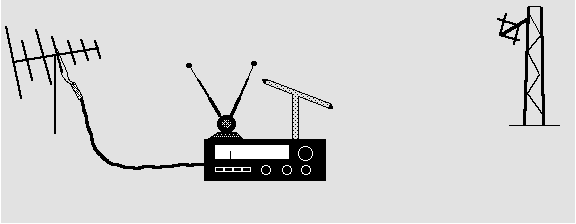Wave Magnets for the Masses
or How To Absorb More FM

Tired of noisy nasties that aren’t in the song when listening to yer fave low-power FM broadcast station? Clock this, y’all:
Radio Ain’t Necessarily Pretty
Radio folks all too often hear, “Sounds interesting, but i can’t pick up your station {fill in one or more of: at home, at work, in my car, sometimes at night, depending on the weather, on my portable, on my teeth…}”. While it is true that miniscule under 1kW stations, even high up in the hills, won’t compare with 69kW commercial giants, and the physics of VHF electromagnetic waves virtually dictates that one must have line-of-sight with (or at least be facing toward) the transmitter site, most of you aren’t trying hard enough at the receiving end!
Can’t Get ’Nuff Respect…
When presented with the above query, i typically ask, “What are you using for an antenna?” The all-too-common puzzled look or blank expression tells me all i need to know…. Are you expecting miracles?
Remember, FM radio signals work just like VHF TV signals (in fact, the entire FM band is just above channel 6, and well below channel 7!). For some reason, nearly everyone realizes TV signals need T.L.C., but FM can’t get ’nuff respect! One of the great undying myths of our time is that FM radio sound quality never gets better than whatever you get with a little ole hunk o’ wire tacked on the back of the tuner, sagging to the floor, or whatever your local cable monopoly feels like dissing—uh, ’scuse me—dishing out this week. People actually expect to hear the sounds of the Russian River at flood stage mixed with their pet sounds when they go from mono to stereo. Well, i’m here to testify IT AIN’T GOTTA BE SOOO!!!!
As a rooftop antenna user since 1986, i’m here to say that i get all kinds of low power stations listenably, and a local one where i used to work (KALX) just as clean at home as in the air studio. Sorry—correction: better than monitoring the off-air signal in the air studio (i have a better antenna and clearer line-of-sight than the studio, even though i’m much farther away). Except for a few processing artifacts, it’s as clean as the straight-out-de-board signal. That little T-shaped hunk of wire that came with your receiver (which may or may not be a true folded dipole) was designed for picking up 50 bizillion watt stations 3 blocks away. Give your receiver/tuner a break!
Check out the amaaaazing things i discovered when i did an informal survey of the relative performance of various FM receiving antennae.
So yer sayin’, “Look chump, i’m a Sillycon Vallee techead from way back, with more degrees and patents than you’ve got fingers, and i’m mainline Webbin’ while it took you a year to escape AOL. I eat baluns for breakfast and doodle Smith Charts in my sleep. I done did all worth doing above, and i still don’t get my fave station worth tiddlywinks! Whatcha got that i don’t already know, chump?”
Nothing. (Assuming you actually know what you think you know).
If you really can’t stand these here pages, check out the competition:
- The Consumer Electronics Association (CEA) AntennaWeb TV Antenna Selector site (substitute “FM” in your mind whenever you see “TV”)
- you might like the TV Antenna Info FAQ
- there’s always Hints For Better Reception from KVNO, Omaha
- or see what an audiophile tuner manufacturer has to say on the subject
- lots more via a Google search on "FM Reception Tips", most of which i have not seen and may or may not suck.
But it’s interesting how often the technically savvy will miss an important detail, esp. outside their own discipline. Everyone, both neophytes and chumps, remember: make the antenna as high as possible, and keep the lead-in cable short. And dude, if you really doodle Smith Charts in your sleep, why didn’t you write this article, chump?
